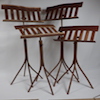Hi there! I'm currently working on my first all hardwood project. New to this so a lot can go wrong!
Looking to make a simple box styled coffee table with a divider. I did a rough model of it:
table.jpg
Anyways. I have an old 4x5 field camera that uses beautiful box joints and I would love to replicate that look. I've done 3/4" box joints on plywood for end tables before on a jig I made on the tablesaw but these panels are 22"x44" and holding that vertically on the table saw sled sounds dangerous. I'm also hoping to make the fingers smaller, 1/4". Maybe this is a crazy plan for my first big furniture project but I'm curious to hear thoughts on how I could accomplish this from all the experienced folks here.
Thanks!




 Reply With Quote
Reply With Quote


 Box joints can be done by hand, too, in the same way and some simple wood guides to keep the tools cutting straight and true make it a reasonable option.
Box joints can be done by hand, too, in the same way and some simple wood guides to keep the tools cutting straight and true make it a reasonable option.


